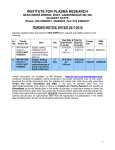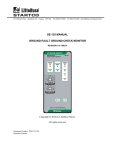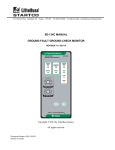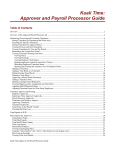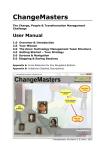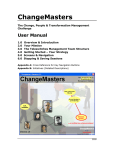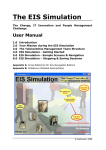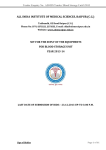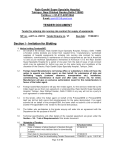Download INSTITUTE FOR PLASMA RESEARCH
Transcript
INSTITUTE FOR PLASMA RESEARCH NEAR INDIRA BRIDGE, BHAT, GANDHINAGAR 382 428 GUJARAT STATE Phone: 079 23962021, 23962023 Fax: 079 23962277 TENDER NOTICE DATED 5-6-2009 Itemwise sealed tenders are invited from reputed and eligible parties for the following. Sr. Tender Notice No No. 1. 2. 3. 4. IPR/TN/PUR/0 15/09-10 IPR/TN/PUR/0 16/09-10 IPR/TN/PUR/0 17/09-10 IPR/TN/PUR/0 18/09-10 (TWO PART TENDER) Item Supply, installation and commissioning of DSP based state-of-art 20 kVA UPS System Design, detail engineering, manufacture, inspection, erection and commissioning of 1 MVA, 11 kV/433V, 3 phase, 50 Hz, oil cooled Transformer Design, fabrication, supply, installation, commissioning and testing of Acoustic Enclosure Design, manufacture, inspection, testing, erection and commissioning of Diesel Generator set with a minimum capacity of 500 kVA along with all auxiliaries and accessories Quantity 2 Nos. Due Date & time of opening 16/07/2009 2.30 p.m. Tender Fee (Rs.) EMD (Rs.) 200.00 10,000.00 1 No. 17/07/2009 2.30 p.m. 200.00 10,000.00 1 No. 22/07/2009 2.30 p.m. 200.00 15,000.00 1 No. 23/07/2009 2.30 p.m. 200.00 20,000.00 Tender documents are available on IPR Website : www.ipr.res.in//purchasetenders.html. Tenderers meeting the eligibility criteria mentioned in the tender documents may, at their option, download the tender documents from the website and submit their offer along with prescribed Tender Fee (non refundable) and EMD in the form of Demand Draft from any nationalized/scheduled bank drawn in favour of Institute for Plasma Research and payable at Ahmedabad as per the details given in the tender documents. In case party desires to collect the tender documents by post, they may contact the Purchase Officer along with prescribed tender fee. Tender documents will be issued upto 26/06/2009. The representative who is going to attend the tender opening should carry an authorization letter from the organization for participation in the tender opening. 1 TENDER NOTICE No.IPR/TN/PUR/015/09-10 DATED 5/6/2009 For Supply, installation and commissioning of DSP based state-of-art 20 kVA UPS System – 2 Nos. NOTE: 1. Full details and specifications of the items and general instructions to be followed regarding submission of tenders are indicated in the tender documents. 2. Proof for fulfillment of eligibility criteria mentioned hereunder should be submitted along with the tender. If the tender is submitted without valid documents, we shall not consider your offer. Tenders received without proof of eligibility criteria will be rejected. 3. Tender documents can also be obtained by submitting a written request to the Purchase Officer together with prescribed tender fee, provided that the eligibility criteria is fulfilled. Last date for issue of Tender documents is 26/06/2009. 4. While requesting for Tender Documents, such request shall indicate the “REQUEST FOR TENDER DOCUMENTS AGAINST TENDER NOTICE NO.IPR/TN/PUR/ 015/09-10 DATED 5/6/2009”. 5. The tender fee of Rs.200/- (non refundable) should be made in the form of DEMAND DRAFT from any nationalized/scheduled bank drawn in favour of Institute for Plasma Research and payable at Ahmedabad. Vendor’s name and tender number shall be indicated on the reverse side of the Demand Draft. 6. DD should not be prior dated to the date of advertisement. Separate request letter and separate Demand Draft shall be sent for each tender. 7. Those who use the downloaded tender documents from IPR Website may submit the prescribed Tender Fee keeping in a separate envelope along with the tender. 8. Tenders received without the prescribed tender fee will be rejected. 9. No request for the extension of due date will be considered. 10. Late/Delayed offers will not be accepted. 11. Tenders in a sealed envelope superscribing the envelope with the above tender no., date, due date and brief description of tendered item along with EMD for Rs.10,000/- by way of Demand Draft from a nationalized/scheduled bank drawn in favour of Institute for Plasma Research and payable at Ahmedabad should be submitted to the Purchase Officer at the above address by 1.00 p.m. on 16/07/2009. Tenders received upto 1.00 p.m. on 16/07/2009 will be opened on the same day at 2.30 p.m. in the presence of attending tenderers. 12. In the event of any date indicated above is a declared Holiday, the next working day shall become operative for the respective purpose mentioned herein. 2 13. IPR will not be responsible for any delay/loss of documents in transit. 14. Tenders received without the details asked for including proof of eligibility for participating in the tender may not be considered. 15. Tenderers should furnish/enclose full technical details/literature, delivery period and confirm the terms and conditions attached with the tender. 16. Those who do not meet with the eligibility criteria need not submit Tender. 17. Those who are quoting on behalf of their foreign Principals should submit a Proforma Invoice of Foreign Principals in foreign currency. 18. The Director, IPR reserves the right to accept or reject any offer in full or part thereof without assigning any reason thereof. 19. Quotations received without EMD will not be considered. 20. The representative who is going to attend the tender opening should carry an authorization letter from the organization for participation in the tender opening ELIGIBILITY CRITERIA: 1. The supplier should be either Manufacturer or Authorized Distributor. (In case of Authorized Dealer, attach valid dealership Certificate) 2. The company should be in the business of manufacturing/supplying industrial load like PLC UPS of 20 KVA and higher capacity for 5 years and more. 3. The turn-over of the company should be more than 1.0 Crore. 4. The company should have its service centre (with trained persons) at Ahmedabad/ Gandhinagar to carry out prompt repair if required to ensure minimum downtime. The same should be mentioned along with address. Enough spares should be kept available at these locations. 5. The downtime assurance should be less than 1 Hr. in 365 days (5 Nine Quality standards). 6. The product should be “Environment friendly”, i.e. company must have adopted “Green standard” policy, approved by International agency, while manufacturing UPS. 7. The bidder must have supplied minimum two nos. of similar or higher capacity UPS in the country during last two financial years. Bidder shall submit documentary evidence of satisfactory performance from the customer along with the features activated. Name, address and contact phone numbers of the concerned authority issuing the satisfactory performance should be provided with your quotation. 3 NOTE: Issue of tender documents does not mean that a vendor is qualified to submit tenders. IPR’s decision to consider as to whether a vendor has met with the eligibility criteria is final. INSTRUCTIONS TO BIDDERS AND TERMS AND CONDITIONS 1. The quotation and any order resulting from this tender/enquiry shall be governed by our Conditions of contract and supplier quoting this tender shall be deemed to have read and understood the same in toto. 2. Where counter terms and conditions have been offered by the supplier, the same shall not be deemed to have been accepted by us, unless our specific written acceptance thereof is obtained. 3. Tender Fee: Tenders received without the prescribed Tender Fee will be rejected. 4. Clarifications: Any technical and commercial questions, information, clarifications, etc. that may be required pertaining to this Tender/enquiry may be obtained from the Purchaser before submitting the tender. 4.1 Bids shall be complete in all respects and shall include properly filled in prices, other specifications, schedules, relevant drawings and catalogues as necessary alongwith the bid covering letter, all in duplicate. 5. Quotation: Your quotation superscribing our tender/enquiry No., date, due date and short description of item should be submitted to the Purchase Officer, IPR in a sealed envelope on or before the due date. Late and delayed quotations will not be considered. IPR will not be responsible for postal delays or any other delays in receipt of quotation. Envelopes received without Tender number, date, due date and short description of item may be rejected. The quoted prices should be firm for a period of 120 days from due date for placing order. IPR is not bound to accept lowest rate/s. IPR reserves the right to place order on one or more parties irrespective of whether he is lowest or not. The scope of supply includes insurance by the Contractor/Supplier. 6. Specifications: Material should be offered strictly conforming to our specifications/drawings. Deviation, if any, should be clearly indicated by the supplier in their quotation. The supplier should also indicate the Make/Type number of the materials offered and catalogues, technical literature and samples, wherever necessary should accompany the quotation. 7. Terms of prices: Quotation should be submitted on door delivery basis without extra charge wherever possible. For quotations on Ex-Works, Ex-godown basis the approximate packing and forwarding charges should be indicated by the supplier. In the case of local suppliers, the material is to be delivered at our stores free of charge. Unit rate/s should be valid throughout the validity of purchase order/contract period for addition/deletion purposes. Break-up of price should be furnished. The quoted price should not be subject to price escalation for whatsoever reasons. The quoted price shall 4 be firm, fixed and non-revisable during the validity/extended validity of purchase order/contract. 7.1 Prices are required to be quoted according to the units indicated in the tender form. When quotations are given in terms of units other than those specified in the tender form, relationship between the two sets of units must be furnished. 7.2 Wherever options are specified in the tender documents, IPR reserves the right to accept any option/s irrespective of whether all the vendors have quoted for all the options or not. The decision of IPR in this regard will be final. 8. Tender should be free from Correction and Erasures. Corrections, if any, must be attested. All amounts shall be indicated both in words as well as in figures. Where there is difference between amounts quoted in words and figures, amount quoted in words shall prevail. 9. IPR shall be under no obligation to accept the lowest or any tender and reserves the right of acceptance of the whole or any part of the tender or portion of the quantity offered and the tenderers shall supply the same at the rates quoted. 10. Sales Tax etc.: We have no "C" or "D" form. The percentage of Sales Tax/VAT, surcharge, if applicable, and other levies legally leviable and intended to be claimed should be clearly indicated in the tender. Where this is not done, no claim on these accounts would be admissible later. 10.1 VAT Registration: You may submit a copy of VAT Registration certificate along with your quotation (if applicable). 10.2. Service Tax: Wherever Service tax is applicable, it should be mentioned clearly. You may indicate percentage of Service Tax in your quotation. 10.3 Excise Duty: As per Notification No.10/97-CE (Central Excise) dated 1-3-1997, the Purchaser is entitled for availing Excise Duty exemption at present. Excise Duty Exemption Certificate, wherever applicable, and as per rules will be issued at the appropriate time. Hence Excise Duty should not be included in the BID. However, prevailing percentage of Excise Duty may be indicated. 10.4 Octroi: Octroi is not applicable in our case. 11. Delivery Date: The supplier must indicate the firm delivery date by which the materials will be despatched/delivered by them from the date of our order. 12. Inspection: Materials on its arrival at IPR will be inspected by Stores In-charge, and his decision in the matter will be final. 13. Earnest Money Deposit (EMD): Tenderer should furnish EMD for Rs.10,000/- (Rupees Ten thousand only) by way of Demand Draft from a nationalized/scheduled bank drawn in favour of Institute for Plasma Research and payable at Ahmedabad should be submitted along with quotation. Tender received without EMD will not be accepted. 13.1 EMD of unsuccessful Bidder will be returned after finalizing the Contract/placing Purchase order. 5 13.2 The EMD shall be forfeited in case the selected Bidder does not start the work within the time limit specified or fail to complete the work within the stipulated delivery period or fail to comply with any of the terms and conditions in the purchase order/contract. 14. Payment: Within 30 days from the date of acceptance. Wherever, advance payment is involved, it will be paid only against Bank Guarantee from Nationalised/Scheduled Bank. 15. No correspondence will be entertained within 30 days from the date of receipt of material and bills, whichever is later. 16. Quotation should be valid at least for 120 days from the date of opening of the tender. 17. Delivery periods be clearly indicated against each item separately. 18. Guarantee: The Stores/material/goods/equipment offered by the bidder should be guaranteed for a minimum period of twelve months, against defective materials, design, workmanship, operation or manufacture. For defects noticed during the Guarantee period, replacement/ rectification should be arranged free of cost within a reasonable period of such notification. In cases where our specifications call for a guarantee period more than 12 months specifically, then such a period shall apply. 19. Security Deposit: The successful Bidder will have to furnish to the Purchaser an interest free security deposit for 10% (Ten percent) of the order value in the form of Bank Guarantee of an equivalent amount from a nationalised/scheduled Bank within 15 days from the date of LOI/Purchase order and the said Guarantee should be valid till the goods are accepted by IPR. The Security deposit shall be forfeited in case the selected Bidder does not start the work within the time limit specified or fail to complete the work within the stipulated delivery period or fail to comply with any of the terms and conditions in the purchase order/contract. 20. Liquidated Damages: In addition to forfeiting Security Deposit, Liquidated Damages for the delay shall be 1/2% (half percent) of the total order value for the delay of each week in the scheduled time of supply or the scheduled date of final completion for the work as the case may be, subject to a maximum of 5% (five percent) of total order value. Liquidated Damages will be recovered from the payment due to the supplier. 21. Performance Bank Guarantee: The Contractor/Supplier will have to furnish to the Purchaser (IPR) an interest free performance bank guarantee for 10% (Ten percent) of the order value/ contract value by Demand Draft or by way of providing a Bank Guarantee from a Nationalised/Scheduled Bank valid for a period of 12 months/guarantee period mentioned in the order from the date of installation/acceptance for satisfactory performance of the work carried out by the Contractor. 22. The Contractor/Supplier shall at all times indemnify the purchaser against all claims which may be made in respect of the stores/material/goods/equipment for infringement of any right protected by Patent Registration of design or Trade Mark and shall take all risk of accidents or damage, which may cause failure of supply from whatever cause arising and the entire responsibility for sufficiency of all means used by him for the fulfillment of the contract. 23. BAR/PERT Charts: To be provided as per the requirement of Purchaser. 6 24. Sub-Contract: All sub-contractors are required to be appraised and approved by the Purchaser before placement of orders by the Vendor. 25. Jurisdiction: The contract/Purchase order shall be governed by the Laws of India for the time being in force. The Courts of Ahmedabad only shall have jurisdiction to deal with and decide any legal or dispute arising out of this contract. 26. Settlement of disputes: Any disputes or difference arising out of or in connection with the Contract/Purchase order shall be to the extent possible settled amicably between the parties. If amicable settlement cannot be reached then all disputed issues shall be settled by arbitration. 27. Arbitration: In the event of any dispute or difference arising under this Contract, the matter shall be referred to the Arbitrators one each nominated by the Purchaser and Contractor from their respective organisations. In case the said Arbitrators are not able to settle the dispute by themselves, the matter shall be referred to the Arbitrator mutually nominated by the Purchaser and the Contractor and whose decision will be final and binding on both the parties. The venue of arbitration will be IPR. Subject to as aforesaid the Arbitration Act, 1940 and the rules thereunder and any statutory modification thereof for the time being in force shall be deemed to apply to the Arbitration proceedings under this Contract. 28. Permits and Licences: The Contractor shall secure and pay for all permits and licence which he may require to comply with in respect of all laws, ordinances and regulations of the Government or Public Authorities in connection with the performance of his obligations under the Contract. The successful contractor shall be responsible for all damages and shall indemnify and save the Purchaser harmless from and against all claims for damages and liability which may arise due to his failure to comply with what is stated above. 29. Training: The successful tenderer shall, if required by the Purchaser, provide facilities for the practical training of Purchaser’s engineering or technical personnel for their active association on the manufacturing process throughout the manufacturing period of the Contract/stores, number of such personnel to be mutually agreed upon. 30. Operation/Instruction Manual: Where operation/instruction manual is essential to enable the Purchaser to put the stores to proper use, the successful tenderer shall furnish such operation/instruction manual along with the stores. 31. Test Certificate: Wherever required, test certificates should be sent along with the despatch documents. 32. Secrecy: 32.1 All information, drawings, designs and specifications imparted to the bidder/successful contractor shall, at all times, remain the absolute property of the Purchaser, the bidder/successful contractor shall not use them for purposes other than for which they are provided for and shall treat all these documents as confidential. These shall not be reproduced in whole or in part for any other purpose. 7 32.2 The contractor shall use his best endeavours to ensure that such information are not divulged to third parties except where needed for the performance of the contract by the successful bidder with the prior consent of the Purchaser. In such cases, the successful contractor shall ensure and obtain similar obligation of confidence, from third parties in question. 33. Indemnity: The Contractor shall warrant and be deemed to have warranted that all stores supplied against this contract are free and clean of infringement of any Patent, copy right or trade mark and shall at all times indemnify the Purchaser against all claims which may be made in respect of the stores for infringement of any right protected by patent. Registration of design or Trade Mark and shall all risk of accidents of damage which may cause a failure of the supply from whatever cause arising and the entire responsibility for the sufficiency of all the means used by him for the fulfilment of the contract. 34. Counter terms and conditions of Suppliers: Where counter terms and conditions printed or cyclostyled conditions have been offered by the supplier, the same shall not be deemed to have been accepted by the Purchaser unless specific written acceptance thereof is obtained. 35. Installation/commissioning/site works: Wherever these activities are part of scope of work/specifications, Vendor should carryout out the same without any extra cost to IPR. 36. Free Issue Material (FIM) (If specified in the tender documents): Successful tenderer will have to furnish in the form a Bank Guarantee or in any other form as called for by the Purchaser towards adequate security for the materials/property provided/issued by the Purchaser as Free Issue Material (FIM) for the due execution of the contract. Successful bidder shall submit Bank Guarantee from a nationalized bank and arrange insurance for the cost of FIM at his expenses. 37. Late/delayed tenders will not be accepted. Incomplete tenders may be rejected at the discretion of IPR. 38. IPR is not bound to accept the lowest tender. IPR reserves the right to select any vendor at its sole discretion. 39. Result of the tenders: Unsuccessful tenderers will not be informed of the result of their tenders. 40. The Director, IPR reserves the right to accept or reject any quotation/tenders fully or partly without assigning any reason. 41. IPR reserves the right to place order on a single party or to split the order at its sole discretion. We agree to the above terms and conditions. Place: Signature of Bidder with seal 8 Date: Note: A copy of our terms and conditions duly signed should accompany your quotation. 9 TECHNICAL SPECIFICATION OF True On-Line UPS SYSTEM 20 KVA (2 NOS.) Sr. No. 1. Specification Application 2. Topology 3. Technology 4. Installation 5. Construction Input Parameter 6. Voltage 7. Frequency 8. Power Factor at rated load 9. Operation with reverse phase sequence 10. Input Current Harmonics Distortion (THD-I) 11. Compatibility with Engine Generators Output Parameter 12. Capacity (KVA) 13. Voltage 14. Frequency 15. Wave Form 16. Output Voltage Distortion (THD-I) 17. Load Power Factor 18. Efficiency AC-DC-AC 19. Crest Factor 20. Overload Capacity 21. Protection 22. 23. Bypass Auto retransfer Output Isolation between UPS and Load Industrial Load (PLCs, Instrumentation Rack, PC Load) True on-line, Double conversion, Input PF correction, Classification VFI DSP and Dual Microprocessor Based, PWM Technology using IGBT in Inverter and preferably in Charger with Paralleling Capability Parallel Redundancy Configuration For reliability and flexibility as well as individual operation. Tower 440V AC ± 15%, 3-Phase, 4 – Wire 50 Hz ± 10% 1.0 (Unity) YES. Possible (Automatic synchronization with input phase) <5% Sine wave YES 20 KVA (16 KW) Single Phase, 220/230 VAC ± 1%, 50 Hz ± 0.1% Sine wave, Synchronized zero Transfer time <3% for Non-Linear Loads, <2% for Linear Loads 0.8 or better Greater than 85% 3:1 110% for 60 Min., 125% for 10 Min., 150% for 1 Min Rectifier/Inverter Output Short Circuit Protection and Overload Protection It is required It is required 10 Charger and Battery System 24. 25. 26. 27. 28. 29. 30. 31. 32. Battery Management Battery test facility Battery charging system Rectifier Output Backup time Float Charge Regulation Charger Ripple Types Of Batteries Preferred Brand/Makes Monitoring and Control Power Management Display Communication Port (Smart) Communication Port (Dry) Diagnostics Tools Parallel Redundancy/Hot stand-By Configuration (UPS Change over time) 33. 34. 35. 36. 37. General Operating Temperature Relative Humidity Training Operation and Service Manual Warranty 38. 39. 40. 41. 42. YES. It is required Temperature compensated to increase battery life Short circuit protected 30Min for Each UPS (Full load), 60Min (Half load) ±1% <2% RMS VRLA Lead-Acid (SMF) Exide, Powersafe, Rocket, Quanta Equivalent make with long operational life. LCD, Mimic Diagram with Real-Time information RS-232 And USB with Cable Potential Free Contact YES (specify available diagnostic tools) ≤ 20 mSec 0-45°C 0-95% (Non-Condensing) YES, On-site YES, Hard Copy 1 Year Standard (Vendor should provide quotation Four Years Additional warranty Period) Note: (A) Vender must submit Input Power connection scheme including size and type of protection device and cables and incoming panel. (B) Battery sizing calculation must be provided for specified time. 11 SPECIFICATIONS for a 20 KVA Three - Phase Uninterruptible Power Supply System 1.0 GENERAL 1.1 SUMMARY This specification describes the UPS, an uninterruptible power supply system for workstation, server, network, telecom, Plant PLC station and other sensitive electronic equipment applications. It defines the electrical and mechanical characteristics and requirements for a continuous-duty single-phase, solid-state, uninterruptible power supply system. The uninterruptible power supply system, hereafter referred to as the UPS, shall provide high-quality AC power. 1.2 STANDARDS The UPS shall be designed in accordance with the applicable sections of the current revision of the following documents. Where a conflict arises between these documents and statements made herein, the statements in this specification shall govern. IEEE C62.41, Category A & B ASME CSA 22.2, No. 107.1 FCC Part 15, Sub Part B, Class A National Electrical Code (NFPA 70) NEMA PE-l OSHA EN 50091 Part 2, EN 62040 Part 1 and 3, EN 61000 Part 3 and 6 1.3 SYSTEM DESCRIPTION 1.3.1 General The UPS system (Classification VFI) is required to supply the full rated load. If a power or control module should malfunction, the load is to be transferred automatically to the bypass line. If a battery module should malfunction, it is to be isolated from the system resulting in reduced back up time. 1.3.2 Modes of Operation The UPS shall be designed to operate as a true on-line system in the following modes: A. Normal - The critical AC load is continuously supplied by the UPS inverter. The input converter derives power from a utility AC source and supplies DC power to the inverter. The battery charger shall maintain a float-charge on the battery. B. Back-up - Upon failure of utility AC power the critical AC load is supplied by The inverter, which obtains power from the battery. There shall be no interruption in power to the critical load upon failure or restoration of the utility AC source. 12 C. Recharge - Upon restoration of utility AC power, after a utility AC power outage, the input converter shall automatically restart and resume supplying power to the inverter. Also the battery charger shall recharge the battery. D. Automatic Restart - Upon restoration of utility AC power, after a utility AC power outage and complete battery discharge, the UPS shall automatically restart and resume supplying power to the critical load. Also the battery charger shall automatically recharge the battery. This feature shall be enabled from the factory and shall be capable of being disabled by the user. The user shall also be able to program two auto restart delay settings 1. 2. Battery capacity % level Countdown timer E. Bypass - The bypass shall provide an alternate path for power to the critical load that shall be capable of operating in the following manner: 1. Automatic - In the event of an internal failure or should the inverter overload capacity be exceeded, the UPS shall perform an automatic transfer of the critical AC load from the inverter to the bypass source. 2. Manual - Should the UPS need to be taken out of service for limited maintenance or repair, manual activation of the bypass shall cause an immediate transfer of the critical AC load from the inverter to the bypass source. The input converter, inverter, and battery charging operations shall continue to operate, provided the control enable switch is in the " On " position. 1.3.3 Performance Requirements 1.3.3.1 System A. Configuration: Select UPS systems shall be configured or upgradeable to power ratings as follows: 20 kVA single system- configure/upgrade to 20 kVA redundant systems, as well as individual operation. 20 kVA- single at 0.8 pf. B. Isolation: Input to output isolation shall be provided, via the output transformer, regardless of operating mode. (UPS or bypass) C. Remote Stop: The UPS shall provide provisions for remote stop capability. 13 1.3.3.2 AC Input to UPS A. Voltage Configuration: 310-480 VAC, three-phase, 4-wire-plus-ground. B. Frequency: 45 to 55 Hz. C. Input Current Distortion: 5% THD maximum at full load (Non-linear). D. Input Power Factor: 0.98 lagging at 100% rated load. E. Inrush Current: 150% of full load input current maximum for 3 cycles. F. Surge Protection: Sustains input surges without damage per criteria listed in IEEE C62.41, Category B. 1.3.3.3 AC Output A. Voltage Configuration: 230 VAC, single-phase, 2-wire-plus-ground. B. Voltage Regulation: +/- 1% steady state. C. Frequency Regulation: 50 Hz, +/- 0.5%. D. Frequency Slew Rate: Programmable, 5.0 Hertz per second maximum. E. Bypass Frequency Synchronization Range: +/- 5.0 Hertz. F. Voltage Distortion: 3% total harmonic distortion (THD) maximum into a 100% linear load, 5% THD maximum into a 100% non-linear load with crest factor ratio of 3:1. G. Load Power Factor Range: 0.5 lagging to 1 H. AC DC AC Efficiency: > 85% at 40% Load. I. Maximum Output Power Rating: 20 kVA at: 0.8 lagging power factor. J. Overload Capability: >100% - 110% for 30 Minutes, 125% for 10minutes, 150% for 60 seconds. The load shall be transferred to bypass when any of the above conditions are exceeded. >151% for min. 2 cycles, then shut down of UPS. Immediate shutdown into a short circuit. K. Voltage Transient Response: +/- 5% maximum for any load step up to and including 100% of the UPS rating. L. Transient Recovery Time: To within 1% of steady state output voltage within 110 milliseconds. 14 1.3.3.4 Batteries A. External Battery: The battery shall consist of gas recombination, valve regulated, lead acid cells. Batteries shall be provided, which renders the UPS suitable for installation inside a computer room. B. Reserve Time: (with ambient temperature between 20 and 25 deg C. The UPS shall contain an external battery system to provide a reserve time of 30 minutes at 100% load. 1.4 ENVIRONMENTAL CONDITIONS A. Ambient Temperature: Operating UPS 0 deg C to +45 deg C; battery 20 deg C to 25 deg C for optimum performance. Storage: UPS 0 deg C to +50 deg C; battery 0 deg C to 25 deg C for maximum 6 months. B. Relative Humidity Operating: 5 to 95% non-condensing. Storage: 5 to 95% non-condensing. C. Audible Noise Noise generated by the UPS during normal operation shall not exceed 70 dBA measured at 1 meter from the surface of the UPS. D. Electrostatic Discharge The UPS shall be able to withstand a minimum 15 kV without damage and shall not affect the critical load. 1.5 USER DOCUMENTATION The specified UPS system shall be supplied with one (1) user's manual. Manuals shall include installation drawings and instructions, a functional description of the equipment with block diagrams, safety precautions, illustrations, step by step operating procedures, and routine maintenance guidelines. 1.6 WARRANTY The UPS manufacturer must warrant the UPS against defects in materials and workmanship for one year. The warranty must cover all parts and onsite labor for one year. Maintenance contract packages should also be available for additional 2 to 4 years at chargeable basis, Vendor should provide the separate quotation for a this additional 2 to 4 years warranty. 15 1.7 QUALITY ASSURANCE 1.7.1 Manufacturer Qualifications A minimum of five year's experience in the design, manufacture, and testing of solidstate UPS systems is required. 1.7.2 Factory Testing Before shipment, the manufacturer shall completely test the system, to assure compliance with the specifications. These tests shall include operational discharge and recharge tests on the external battery to guarantee rated performance. 2.0 PRODUCT 2.1 FABRICATION All materials and components making up the UPS shall be new, of current manufacture, and shall not have been in prior service except as required during factory testing. The UPS shall be constructed of replaceable subassemblies. Maintainability aspects should be given prime importance. All active electronic devices shall be solid-state. 2.1.2 Wiring Wiring practices, materials, and coding shall be in accordance with the requirements of the National Electrical Code (NFPA 70) and other applicable codes and standards. 2.1.3 Cabinet The UPS unit comprised of: power module, battery module, control module, system interconnect module and user interface module housed in a single free-standing enclosure and meets the requirements of IP20. The UPS cabinet shall be cleaned, primed, and painted with the manufacturer's standard color. Casters and leveling feet shall be provided. 2.1.4 Cooling The UPS shall be forced air cooled by internally mounted fans. 2.2 COMPONENTS 2.2.1 Input Converter A. General Incoming AC power shall be converted to a regulated DC output by the input converter (IGBT based Rectifier for low current distortion) for supplying DC power to the inverter. The input converter shall provide input power factor and input current distortion correction. The converter output must be shortcircuit protected. 16 B. AC Input Current Limit The input converter shall be provided with AC input over current protection. C. Input Protection The UPS shall have built-in protection against under voltage, over current, and over voltage conditions including low-energy surges introduced on the primary AC source and the bypass source. The UPS shall sustain input surges without damage per criteria listed in IEEE C62.41, Category A & B. The UPS cabinet shall not contain an input breaker. IPR shall supply an input breaker sized to supply full 20kVA rated load and to recharge the battery at the same time. D. Battery Recharge To prolong battery life, the UPS shall contain temperature-compensated battery charging. The battery charger shall be able to recharge the internal batteries to 90% charge in six hours at nominal input voltage and nominal ambient temperature. E. Charger Output Filter The battery charger shall have an output filter to minimize ripple current into the battery. The ripple should be less than 2% RMS. Regulation must be within ± 1%. 2.2.2 Inverter A. General The inverter (IGBT based with DSP and Dual Microprocessor Control) shall convert DC power from the input converter output, or the battery, into precise regulated sine wave AC power for supporting the critical AC load. B. Overload The inverter shall be capable of supplying current and voltage for overloads exceeding 100% and up to 200% of full load current. A visual indicator and audible alarm shall indicate overload operation. For greater currents or longer time duration, the inverter shall have electronic current-limiting protection to prevent damage to components. The inverter shall be self-protecting against any magnitude of connected output overload. Inverter control logic shall sense and disconnect the inverter from the critical AC load without the requirement to clear protective fuses. The load shall be transferred to bypass when any of the above conditions are exceeded. C. Maximum Load Alarm The user can set the alarm point to a value less than 100% rating such that the UPS will alarm before an overload condition or loss of redundancy is reached. D. Output Frequency 17 The output frequency of the inverter shall be controlled by an oscillator. The oscillator shall hold the inverter output frequency to +/- 0.5% for steady state and transient conditions. The inverter shall track the bypass continuously providing the bypass sources maintain a frequency within the user selected synchronization range. If the bypass source fails to remain within the selected range, the inverter shall revert to the internal oscillator. E. Output Protection The UPS inverter shall employ electronic current limiting. F. Battery over Discharge Protection To prevent battery damage from over discharging, the UPS control logic shall control the shutdown voltage set point. This point is dependent on the rate of discharge. 2.2.3 Display and Controls A. General The front panel will consist of multiple status LEDs, switches, and a four line by twenty-character LCD display for additional alarm/configuration information. All mimic display LEDs shall be green in color and indicate the following: AC Input On Battery Load On/Off On Inverter On Bypass The UPS fault indicator is used with additional indicators and an audible alarm to notify the user that a UPS fault condition has occurred. The color of the fault indicator LED shall be amber. Replace Battery Module Replace Power Module Replace Control Module On Bypass Low Battery 18 Over Temp Warning UPS Shutdown If there is a fault condition, the UPS shall attempt to maintain conditioned power to the load or at minimum transfer to bypass. There shall also be indication on each module should the module fail and need to be replaced. In addition to a visual fault signal, the UPS shall also record fault occurrences in a rolling event log. The event log on the standard unit shall record up to 255 occurrences, with the oldest events discarded first, etc. The user shall have access to the event log through the LCD display. Every alarm and/or event recorded in the event log will contain a time and date stamp. B. Audible Alarms The volume of all audible alarms shall be at least 65dBA at a distance of one meter (three feet). An audible alarm shall be used in conjunction with the LED/LCD indication to indicate a change in UPS status. The audible alarms shall enunciate for utility line loss, low battery (while on battery), and all other alarm conditions. For all alarm conditions, the user must look at the display to determine the cause of error/alarm. All alarm tones shall be a continual tone until the condition rectifies itself or the alarm is silenced. Once silenced, the audible alarm shall not sound until a new alarm condition is present. C. Alarm Silence Button In addition to the load on/off switch, the user interface shall include an audible Alarm Silence' switch. If the alarm silence switch is pressed for one second, all current audible alarms shall be disabled. If a new alarm occurs, or a cancelled alarm condition disappears and then re-appears, the audible alarm is re-enabled. D. LCD Display The LCD display shall be used to provide information to the user. The display shall also be used to program ALL information (voltage, frequency, etc.) into the UPS. Any display values that require time/date shall be `year 2000' compliant. 2.2.4 Automatic Battery Test The UPS shall initiate an automatic battery testing sequence periodically, at a programmed day and time of day, selectable by the end user. The user will be 19 able to select the interval of the battery test and will be able to select 1, 2, 3, 4, or 6- week intervals, or can select to disable the automatic battery test. Should a failure of the battery occur, the UPS will immediately return to normal mode and fault signals (visual, audible, and remote via serial) shall be communicated. No audible or remote (via serial/contact closures) indication of the battery test shall be communicated during the duration of the automatic battery test. The automatic battery test factory default settings shall be enabled at a twoweek interval and to occur on any day and time (based on the twenty-four hour clock) defined by user. 2.2.5 Remote Emergency Power Off (REPO) The remote emergency power off function (REPO) shall allow the user to disable all UPS outputs in an emergency situation. The REPO, in order to be flexible, shall be able to interface with either normally open (N.O.) or normally closed (N.C.) systems. The REPO shall be activated when pair of `SELV’ contacts, external to the UPS, are activated. The REPO connection shall be through a simple terminal block type connector. The REPO function shall not operate if no system control modules are present in the UPS or if the manual bypass switch is in the bypass position. The user must also supply a means of interfacing with the REPO circuit to allow disconnecting the UPS input feeder breaker to remove all sources of power to the UPS and the connected equipment to comply with local wiring codes/regulations. Regardless of the UPS mode of operation when the REPO is activated, the UPS output should not be re-enabled until the following occurs: · REPO contacts are reset (closed if N.C. contacts are used and open if N.O. contacts are used) · Input circuit breaker is closed · Control enable switch is turned on · User interface on/off switch is depressed 2.2.6 Bypass A. General A bypass circuit shall be provided as an integral part of the UPS. The bypass control logic shall contain an automatic transfer control circuit that senses the status of the inverter logic signals, and operating and alarm conditions. This control circuit shall provide a transfer of the load to the bypass source, without exceeding the transient limits specified herein, when an overload or malfunction occurs within the UPS. 20 B. Automatic Transfers The transfer control logic shall automatically activate the bypass, transferring the critical AC load to the bypass source, after the transfer logic senses one of the following conditions: Inverter overload capacity exceeded Inverter over temperature UPS fault condition For inverter overload conditions, the transfer control logic shall inhibit an automatic transfer of the critical load to the bypass source if one of the following conditions exists: Inverter/Bypass voltage difference exceeding preset limits (±15 % of nominal) Bypass frequency out of preset limits (± 5 % of nominal frequency) C. Automatic Retransfer Retransfer of the critical AC load from the bypass source to the inverter output shall be automatically initiated unless inhibited by manual control. The transfer control logic shall inhibit an automatic retransfer of the critical load to the inverter if one of the following conditions exists: Bypass out-of-synchronization range with inverter output Overload condition exists in excess of inverter full load rating UPS fault condition present D. Manual Transfer In addition to the internal bypass function, the UPS shall have a manual bypass function. The manual bypass function shall be provided via a switch mounted on the bottom-front of the UPS, removal of the lower front bezel shall be required. The actual AC break time between inverter and bypass shall be less than four milliseconds. The manual bypass shall also be a partial `wrap-around' bypass, and shall be configured to wrap around the rectifier, battery charger, inverter, and battery in the same manner as the automatic bypass. The manual bypass shall not wrap around the EMI filtering, over current protection or isolation transformer. The UPS shall initiate an audible alarm upon transfer to manual bypass. The audible alarm shall be capable of being silenced by the user. The alarm shall continue to sound (unless silenced) while in bypass mode. This shall provide a reminder to the user that the loads continue to be powered from utility supply alone. 21 2.2.7 External Battery Valve regulated, gas recombination, lead acid batteries shall be used as a storedenergy source for the specified UPS system. The battery shall be housed in separate rack and sized to support the inverter at rated load and power factor, in an ambient temperature between 20° and 25° C, for a 20 minutes reserve time. The expected life of the battery shall be 3 to 5 years or a minimum 250 complete discharge cycles. 2.3 ACCESSORIES (OPTIONAL COMPONENTS) 2.3.1 External Battery Cabinets The UPS shall have the capability to add external battery cabinets to the base product. These external battery cabinets with front access battery terminals, shall be installed in parallel to provide backup times as required. The connections between the UPS and the extended battery cabinets shall contain DC power only. All of these shall be able to be connected or disconnected safely by the user without interrupting power to the load. 3.0 3.1 FIELD SERVICES FIELD QUALITY CONTROL Factory trained field service personnel shall perform the following inspections and test procedures during the UPS start-up. 3.1.1 Visual Inspection A. B. C. E. Inspect equipment for signs of shipping or installation damage. Verify installation per drawings. Inspect cabinets for foreign objects. Verify neutral and ground conductors are properly sized and configured. 3.1.2 Mechanical Inspection A. B. C. Check all power modules are correctly fitted. Check all battery modules are correctly fitted. Check all terminal screws, nuts, and/or spade lugs for tightness. 3.1.3 Electrical Inspection A. B Confirm input voltage and phase rotation is correct. Verify bypass voltage jumper is correct for voltages being used. 22 3.2.1 ACCEPTANCE TEST AND UNIT START-UP AT IPR The manufacturer's field service personnel shall provide for site testing. Site testing shall consist of a complete test of the UPS system and the associated accessories supplied by the manufacturer. The test results shall be documented, signed, and dated for future reference, Site acceptance tests are following, 1. 2. 3. 4. Output voltage. Output frequency. Battery Discharge test. Operation of UPS. Parallel Operation. Hot Stand-by Operation. Individual Operation. During Parallel and Hot Stand-By Configuration UPS should change over the load with in 20msec, during any Electrical fault. Load must be remaining “ON” during change over operation 3.3 MANUFACTURER'S FIELD SERVICE 3.3.1 Service Personnel The UPS manufacturer shall directly employ a nationwide service organization, consisting of factory trained Customer Engineers dedicated to the start-up, maintenance, and repair of UPS and power equipment. The organization shall consist of factory-trained Customer Engineers working out of District Offices in most major cities. An automated procedure shall be in place to insure that the manufacturer is dedicating the appropriate technical support resources to match escalating customer needs. The manufacturer shall provide a fully automated national dispatch center to coordinate field service personnel schedules. One toll-free number shall reach a qualified support person 24 hours/day, 7 days/week and 365 days/year.If emergency service is required, call back response time from a local Customer Engineer shall be 30 minutes or less. 3.3.2 Replacement Parts Stocking Parts shall be available through an extensive network to ensure around- the-clock parts availability throughout the country. Local Customer Engineers shall stock replacement spare parts with back up available from District Service offices and the manufacturing location. Customer Support Parts Coordinators shall be on-call 24 hours a day, 7 days a week, and 365 days a year for immediate parts availability. 3.3.3 UPS Maintenance Training Maintenance training courses for customer employees should be available by the UPS manufacturer. This training is in addition to the basic operator training conducted as a part of the system start-up. 23 The training course shall cover UPS theory, location of subassemblies, safety, battery considerations and UPS operational procedures. The course shall include AC to DC conversion and DC to AC inversion techniques as well as control and metering, Troubleshooting and fault isolation using alarm information and internal self-diagnostics shall be stressed. 3.3.4 Maintenance Contracts A complete offering of preventive and full service maintenance contracts for both the UPS system and battery system should be available. An extended warranty and preventive maintenance package should be available. Warranty and preventive maintenance service should be performed by factory trained Customer Engineers. Vendor should provide the separate quotation for this additional 2to 4 years warranty. 24
























